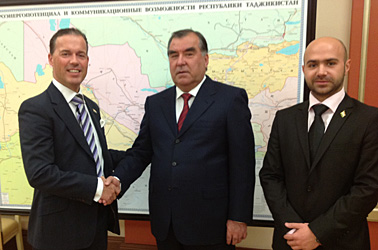
Tajikistan is leading the way in water resource management in Central Asia, providing energy and well-managed water supplies for its neighbors. During my trip to Dushanbe, I visited both the Nurek Dam and the under construction Rogun Dam and I was deeply impressed by the progress I witnessed.
Tajikistan is 93% mountainous and currently only 2% of its hydropower potential is explored. Through the thorough exploitation of its massive water resources, the nation will soon be capable of generating electricity in excess of its own energy requirements. Statistically, Tajikistan currently generates 95% of its electricity from hydroelectric power projects. At 300 meters, the tallest dam in the world is the Nurek Dam in Tajikistan. Poised to become the tallest dam in the world when finished (with a height of 335 meters), the Rogun Dam project is built on the Vakhsh River in southern Tajikistan.
Meeting with the team of competent engineers at Rogun, the history of the Rogun Dam was explained. Going back to the beginning, the project was first discussed during the Soviet era in the 1950’s. The technical schemes were developed in the 1960’s and construction began in 1967. However, with the collapse of the Soviet Union, the project became frozen. It took until 1997 to continue the construction of the dam, when the Tajik civil war ended under the leadership of President Rahmon.
It’s not hard to imagine that energy is badly needed in this fast growing nation. In order to fulfill the rising needs of electricity of the population, as well as to meet the demands of industrial development, more energy is required. In 2010, Tajikistan began to renovate the tunnels that were developed to divert the waters of the Vakhsh River. The main reason for the recommencement of the Rogun Dam plan was to address the socio-economic problems because of an acute shortage of electricity power, especially during the winter time, as well as to ensure sustainable economic development of the country and to raise the welfare of the population.
During the Soviet period, economic cooperation between the independent soviet republics was coordinated by Moscow. In the summer, the hydropower plants of Tajikistan would export energy to Uzbekistan, and in turn, Uzbekistan would export gas to Tajikistan in the winter. The dams form a large lake that allow for effective management of water resources, saving water for irrigation in the dry summer.
It is an undisputable fact that when operational, Rogun will produce a massive 3600 megawatts at peak capacity. Over 45 miles of Soviet-era underground tunnels are already in place. The Rogun dam will be the highest dam in the world, at 335 meters. The dam will be formed between two very high rock formations and a very narrow path of the river. The bottom part of the dam will be 1200 meters wide and the top part will still be 20 meters wide. At present, the lab of the Rogun Dam base is testing all the formations of cement, rock, and sand, to make sure that they create a dam that is extremely strong but also can move along with earthquakes of 9 on the Richter scale. It is important to note that the worst earthquake in this part of the world averaged at 5 on the Richter scale.
After the visit, I came to understand that this mega project could become a major supplier of electricity to Pakistan through Afghanistan. Once it is up and running, Rogun will provide a source of cheap, plentiful and environmentally friendly energy, which will meet the need of Tajikistan while also providing essential energy for neighboring countries.
Thieu Cuypers,
President of Big Media Group (Brussels)
July 15th 2015
